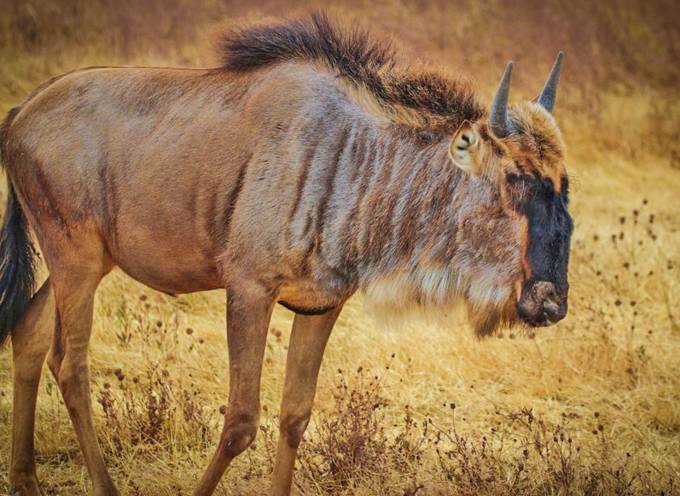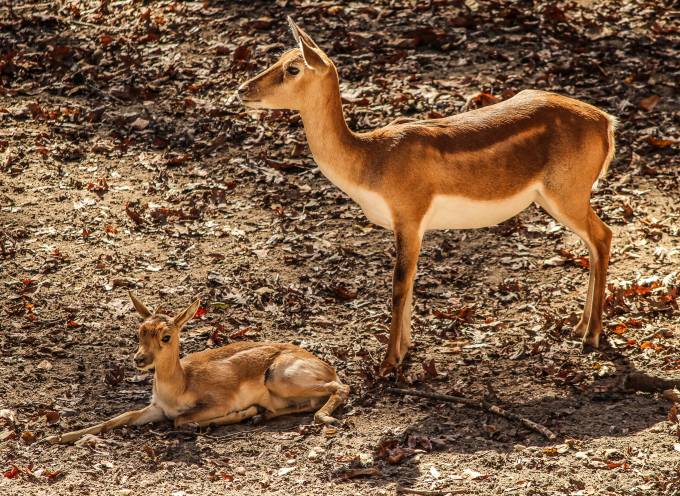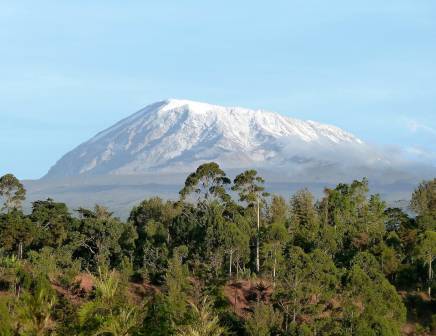
Africa's Great Migration
View Migration SafarisAnimals of the Great Migration
The animals that migrate in Africa are all herd animals - which is why the sheer number of animals involved in the migration is so staggering! Travellers will be able to see wildebeest, zebra, and many different species of antelope.

Blue Wildebeest
The blue wildebeest, also known as the common wildebeest or the brindled gnu, is one of the most commonly seen animals in the Great Migration. Called "blue" because of their bright silvery-blue coats, the Khoikhoi people (a group of native pastoralists who live in southwestern Africa) gave them the name "gnu."
Weight: 250 kg
Lifespan: 20 years
Diet: Grass
Zebra
One of Africa's most iconic animals, zebras are always easy to spot, thanks to their vibrant black and white striped bodies. But did you know that those stripes actually act as camouflage? As each zebra has a unique stripe pattern, a herd of zebras standing close together creates a mesmerizing pattern that predators can find difficult to breach.
Weight: 350 kg
Lifespan: 20 to 30 years
Diet: Grass
Antelope
Travellers will find many species of antelope on their Great Migration safari, including gazelles, impalas, and elands. These horned creatures resemble deer, and range in size from 40 centimetres (15 inches) in height to 1.6 metres tall (6ft), depending on the species.
Weight: 40 to 80 kg
Lifespan: 13 to 15 years
Diet: Grass
Great Migration: Everything You Need to Know
Why does the Great Migration occur?
The Great Migration happens because of the change in seasons. When the dry season arrives in a region and water and food supplies dwindle, animals such as wildebeest migrate to wetter plains in search of grass to graze on and water to drink.
Can I see a black wildebeest in Kenya or Tanzania?
Blue wildebeests are native to Southern and Eastern Africa, including Kenya and Tanzania.
Black wildebeests, on the other hand, can only be found in Southern Africa. Unlike blue wildebeests, black wildebeests do not migrate; instead, this species tends to occupy particular territories.Where is the Great Migration in September?
By September, the herds have usually migrated to northern Serengeti, which is where one of the most frightening elements of their migration occurs: crossing the perilous Mara River.
Where is the Great Migration in January?
In January, the herds are typically starting to settle into the plains around Lake Ndutu, and the best game viewing during this month stretches across much of the southern Serengeti and the northern Ngorongoro Conservation Area. This is a particularly exciting time in the Great Migration as it's often when calving begins.
What should I pack for my safari tour?
To make your safari trip a success you'll need light layers, comfortable shoes, bug spray and binoculars among other things! See our comprehensive packing list for more details.
Why should I go on a Great Migration safari?
Finding the Big Five in the wild is one of the most appealing aspects of an African safari, but the Great Migration is all about witnessing one of the most impressive wildlife events on the planet. Nothing quite compares to seeing the power of the migration up close — it’s truly a once-in-a-lifetime experience!
How can I book a safari to see the Great Migration?
The easiest way to book a safari to see the Great Migration is to look for deals on TourRadar. While it can be hard to guarantee a sighting of the Great Migration, if you position yourself in the right region at the right time and have a knowledgable tour guide on your side, you have a great chance of experiencing this spectacle!
How to choose the right safari?
To make the decision-making process a bit easier, ask yourself the following questions: What time of year can I travel? What animals do I most want to see? What safari activities do I want to do? Once you’ve determined the answers to these questions, you’ll be able to better narrow down your options and choose the perfect safari for you.
Best Places to Witness the Migration
While the Great Migration only travels between two countries, travellers should never underestimate the distance between destinations in Africa! To avoid disappointment, carefully research where the migration will be at the time of your visit and plan accordingly.

The Great Migration ends in Kenya's Masai Mara National Reserve each year. The migration will reach Kenya in August and remain there until around December - herds will cross the Mara River (an incredible but dangerous sight, and not one for the faint of heart!) in August. Travellers visiting between September and November will see the Mara plains fill with the travelling herds, as well as impressive predators. From November to December, the rains begin in Kenya, and the herds will begin to move back towards Tanzania, where they'll give birth.
See Adventures
Tanzania's Serengeti National Park is where the Great Migration begins, from late December until July. From December to March, herds will be in northern Tanzania - visit during this time if you'd like to see newborn babies! Between April and May, the herds disperse north and west. This is a rainy period, so road conditions will be rough. In June, which is also mating season, the herds begin moving north once more, and by July they'll have reached the Grumeti River.
See Adventures
Book your Great Migration tour today!
+1 844 311 8331
24/7 Support
Our team of experienced Travel Experts have ventured to hundreds of countries around the globe and have decades of first-hand travel experience to share. Contact us now to have all of your tour-related questions answered!
























